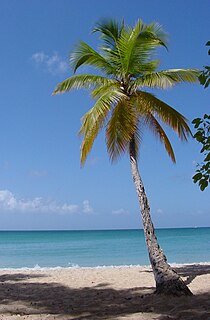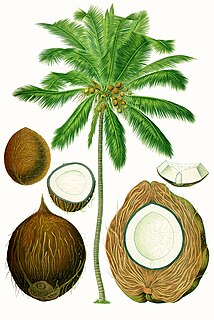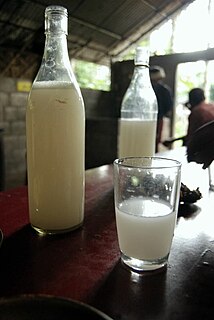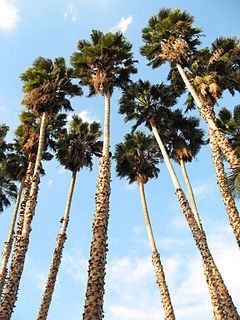
Palm Sunday is a Christian moveable feast that falls on the Sunday before Easter. The feast commemorates Jesus' triumphal entry into Jerusalem, an event mentioned in each of the four canonical Gospels. Palm Sunday marks the first day of Holy Week, the last week of the Christian solemn season of Lent that precedes the arrival of Eastertide.

The Arecaceae is a family of perennial flowering plants in the monocot order Arecales. Their growth form can be climbers, shrubs, tree-like and stemless plants, all commonly known as palms. Those having a tree-like form are called palm trees. Currently 181 genera with around 2,600 species are known, most of them restricted to tropical and subtropical climates. Most palms are distinguished by their large, compound, evergreen leaves, known as fronds, arranged at the top of an unbranched stem. However, palms exhibit an enormous diversity in physical characteristics and inhabit nearly every type of habitat within their range, from rainforests to deserts.

The coconut tree is a member of the palm tree family (Arecaceae) and the only living species of the genus Cocos. The term "coconut" can refer to the whole coconut palm, the seed, or the fruit, which botanically is a drupe, not a nut. The name comes from the old Portuguese word coco, meaning "head" or "skull", after the three indentations on the coconut shell that resemble facial features. They are ubiquitous in coastal tropical regions and are a cultural icon of the tropics.

Sago is a starch extracted from the spongy centre, or pith, of various tropical palm stems, especially those of Metroxylon sagu. It is a major staple food for the lowland peoples of New Guinea and the Moluccas, where it is called saksak, rabia and sagu. The largest supply of sago comes from Southeast Asia, particularly Indonesia and Malaysia. Large quantities of sago are sent to Europe and North America for cooking purposes. It is traditionally cooked and eaten in various forms, such as rolled into balls, mixed with boiling water to form a glue-like paste (papeda), or as a pancake. Sago is often produced commercially in the form of "pearls". Sago pearls can be boiled with water or milk and sugar to make a sweet sago pudding. Sago pearls are similar in appearance to the pearled starches of other origin, e.g. cassava starch (tapioca) and potato starch, and they may be used interchangeably in some dishes.

Twentynine Palms is a city in San Bernardino County, California. It was previously called Twenty-Nine Palms. Twentynine Palms serves as one of the entry/exit points of Joshua Tree National Park.

Yucca brevifolia is a plant species belonging to the genus Yucca. It is tree-like in habit, which is reflected in its common names: Joshua tree, yucca palm, tree yucca, and palm tree yucca.

Palm wine, known by several local names, is an alcoholic beverage created from the sap of various species of palm tree such as the palmyra, date palms, and coconut palms. It is known by various names in different regions and is common in various parts of Africa, the Caribbean, South America, South Asia, Southeast Asia and Micronesia.

Heart of palm is a vegetable harvested from the inner core and growing bud of certain palm trees, most notably the coconut, juçara, açaí palm, palmetto, and peach palm. Harvesting of many uncultivated or wild single-stemmed palms results in palm tree death. However, other palm species are clonal or multi-stemmed plants and moderate harvesting will not kill the entire clonal palm. Heart of palm may be eaten on its own, and often it is eaten in a salad.
Lauric acid or systematically, dodecanoic acid, is a saturated fatty acid with a 12-carbon atom chain, thus having many properties of medium-chain fatty acids, is a bright white, powdery solid with a faint odor of bay oil or soap. The salts and esters of lauric acid are known as laurates.

Washingtonia filifera, also known as desert fan palm, California fan palm, or California palm, is a flowering plant in the palm family (Arecaceae) native to the far southwestern United States and Baja California. Growing to 15–20 m (49–66 ft) tall by 3–6 m (10–20 ft) broad, it is an evergreen monocot with a tree-like growth habit. It has a sturdy, columnar trunk and waxy, fan-shaped (palmate) leaves.

Washingtonia robusta, the Mexican fan palm or Mexican washingtonia, is a palm tree native to western Sonora and Baja California Sur in northwestern Mexico. It is reportedly naturalized in Florida, California, Hawaii, Texas, parts of the Canary Islands, Italy, Israel, Lebanon, Spain, and Réunion.

Phoenix canariensis is a species of flowering plant in the palm family Arecaceae, native to the Canary Islands. It is a relative of Phoenix dactylifera, the true date palm. It is the natural symbol of the Canary Islands, together with the canary Serinus canaria. Mature P. canariensis are often used in ornamental landscaping and are collected and transplanted to their new planting location. A Canary Island date palm with 10 m (30 ft) of trunk is approximately 60 years of age.

The palm branch is a symbol of victory, triumph, peace, and eternal life originating in the ancient Near East and Mediterranean world. The palm (Phoenix) was sacred in Mesopotamian religions, and in ancient Egypt represented immortality. In Judaism, the lulav, a closed frond of the date palm is part of the festival of Sukkot. A palm branch was awarded to victorious athletes in ancient Greece, and a palm frond or the tree itself is one of the most common attributes of Victory personified in ancient Rome.

Palm Springs is a desert resort city in Riverside County, California, United States, within the Colorado Desert's Coachella Valley. The city covers approximately 94 square miles (240 km2), making it the largest city in Riverside County by land area. With multiple plots in checkerboard pattern, more than 10% of the city is part of the Agua Caliente Band of Cahuilla Indians reservation land. Traditionally the Cahuilla refer to the Palm Springs area as Sec-he or Se-Khi.

Caryota urens is a species of flowering plant in the palm family, native to Sri Lanka, India, Myanmar and Malaysia, where they grow in fields and rainforest clearings, it is regarded as introduced in Cambodia. The epithet urens is Latin for "stinging" alluding to the chemicals in the fruit. Common names in English include solitary fishtail palm, kitul palm, toddy palm, wine palm, sago palm and jaggery palm. Its leaf is used as fishing rod after trimming the branches of the leaf and drying. According to Monier-Williams, it is called moha-karin in Sanskrit. It is one of the sugar palms.

Sabal palmetto, also known as cabbage-palm, palmetto, cabbage palmetto, blue palmetto, Carolina palmetto, common palmetto, swamp cabbage and sabal palm, is one of 15 species of palmetto palm. It is native to the Southern United States, as well as Cuba, the Turks and Caicos Islands, and the Bahamas.

Mauritiella is a dioecious genus of flowering plant in the palm family found in South America where it is commonly called buriti. It is named after the similar and closely related genus Mauritia.

In botany, a tree is a perennial plant with an elongated stem, or trunk, supporting branches and leaves in most species. In some usages, the definition of a tree may be narrower, including only woody plants with secondary growth, plants that are usable as lumber or plants above a specified height. In wider definitions, the taller palms, tree ferns, bananas, and bamboos are also trees. Trees are not a taxonomic group but include a variety of plant species that have independently evolved a trunk and branches as a way to tower above other plants to compete for sunlight. Trees tend to be long-lived, some reaching several thousand years old. Trees have been in existence for 370 million years. It is estimated that there are some three trillion mature trees in the world.

Sabal mexicana is a species of palm tree that is native to far southern North America. Common names include Rio Grande palmetto, Mexican palmetto, Texas palmetto, Texas sabal palm, palmmetto cabbage and palma de mícharos. The specific epithet, "mexicana", is Latin for "of Mexico."
The Twenty-Nine Palms Band of Mission Indians of California is a federally recognized tribe of Mission Indians with two reservations, one located near the cities of Indio and Coachella in Riverside County, and the other in the city of Twentynine Palms in San Bernardino County, California. While many scholars regard the tribe as being Luiseño, the tribe itself identifies as being Chemehuevi.


















